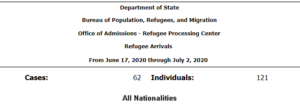And, as of June 17th, the UN/IOM has begun processing refugees to be distributed throughout the west after a brief suspension of the UN/US Refugee Admissions Program.
Checking the data at the Refugee Processing Center, I see that we have admitted another 121 refugees in the two weeks since the hold on resettlement was lifted. In another couple of weeks we should be seeing that number jump as plane tickets are distributed in Asia, Africa, the Middle East and Central and South America.
Just so you know the largest ‘welcoming’ states were California, Illinois and Florida. Here is where they went:


Now to Nayla Rush’s excellent analysis of the health and economic consequences of moving more third worlders to America amid the arguably unprecedented time in US history when every American is worried about getting sick and terrified about being unemployed.
The whole issue of refugee health has been given short shrift throughout the entire time I’ve been writing RRW, so it is no surprise that health concerns are not given serious consideration now!
I have 376 posts in my ‘health issues’ category and figured that it would take some rich peoples’ kids coming home with TB before the public would wake up to what we are doing.
From the Center for Immigration Studies:
Refugee Placement and Medical Concerns Amid a Covid-19 Pandemic and an Economic Crisis
Contagious diseases are key in the determination of inadmissibility to the United States. The Immigration and Nationality Act (INA) requires all refugees applying for U.S. immigration to receive a medical screening to determine inadmissibility on health grounds.11 Specific health-related conditions that pose a threat to public health (called Class A conditions) are grounds for inadmissibility when identified during the medical examination overseas. One class A condition is pandemic flu. New diseases can be added to the list by executive order of the president of the United States. President Trump has yet to update that list with the Covid-19 virus.
Quarantine regulations apply to everyone trying to enter the United States — whether legally or illegally — including refugees. Federal isolation and quarantine are authorized for several communicable diseases, including “severe acute respiratory syndromes; and influenza caused by novel or re-emerging influenza viruses that are causing, or have the potential to cause, a pandemic.”12 (Emphasis added.)
There is no indication that refugees are being tested for the Covid-19 virus overseas or placed under quarantine upon arrival. We know, for instance, that no special pre-departure Covid-19 precautions or testing seem to have been put in place for those refugees coming from Manus Island and Nauru. When asked about this issue, the Australian Home Affairs spokesperson remained vague, referring to general U.S. mandated pre-departure preparations. Father Giorgio Licini, the general secretary of the Catholic Bishops Conference of Papua New Guinea & Solomon Islands, said that “the men did not undergo coronavirus isolation in preparation for their departure.”13 We can assume this to be true of all refugees admitted during this crisis.
But even if they were, why welcome thousands of refugees in the midst of a health and economic crisis?Especially when we know that, on top of being vulnerable to the Covid-19 virus, refugees have specific health needs since they usually come from situations of poor hygienic conditions and health systems with a wide range of unmet health needs (including nutritional deficiencies, hepatitis B infection, tuberculosis infection, parasitosis, etc.) and mental health concerns such as alcohol and drug abuse.14 These health concerns can strain U.S. health and social systems, which are already overwhelmed because of the Covid-19 pandemic.
Resettlement agency representatives determine where refugees are resettled in the United States (usually, and for practical reasons, in states that host their local affiliates). They decide in which state to place a refugee, officially, in an attempt “to match the particular needs of each incoming refugee with the specific resources available in U.S. communities.”15 But how can states like New York, Michigan, and others (who had to deal with stringent stay-at-home orders, large numbers of Covid-19 cases and deaths, rising unemployment, and limited medical capacity and resources such as hospital beds, ventilators, testing etc.) embrace the arrival of refugees into their communities? Were state and local health officials notified of the placement of refugees? Were state residents — who are being asked to continue making enormous sacrifices — informed of such arrivals and risks?
Moreover, how can refugees achieve “self-sufficiency” in the United States when states are just now coming out of lock-down, businesses are going bankrupt, and the employment situation for both immigrants (legal and illegal) and the native-born is disastrous following April and May employment figures?16 Are they just to rely on parts of the relief funds and resources of the CARES Act that are made available to refugees?
[….]
This report will cover the following points:
Refugee arrivals by nationality and destination since the creation of the president’s Coronavirus Taskforce;
Timeline of announcements by world health authorities and the U.S. government in response to Covid-19;
Placement of refugees in American communities: who gets to decide in which states refugees are resettled;
State and local say in the resettlement process, especially when state residents are asked to make important sacrifices amid a health and economic crisis;
Medical screening of refugees before and after resettlement: inadmissibility to the United States on health-related grounds, overseas medical examination of refugees to determine admissibility, domestic medical examination for newly arriving refugees in the United States, medical examination for adjustment of status;
Refugees’ specific health needs;
Access to healthcare and benefits in the United States; and
Relief funds and resources available to refugees following the CARES Act.
You know intuitively that this is insane—welcoming poor/unhealthy people to America right now—but, if you are looking for some facts go here to read Rush’s whole heavily-footnoted report.
